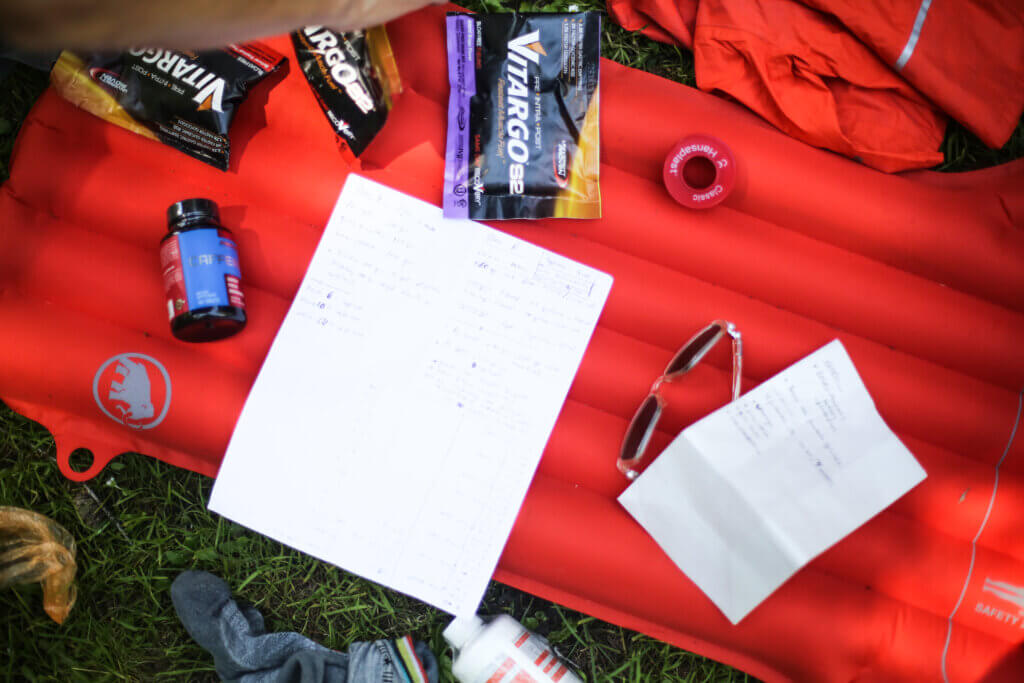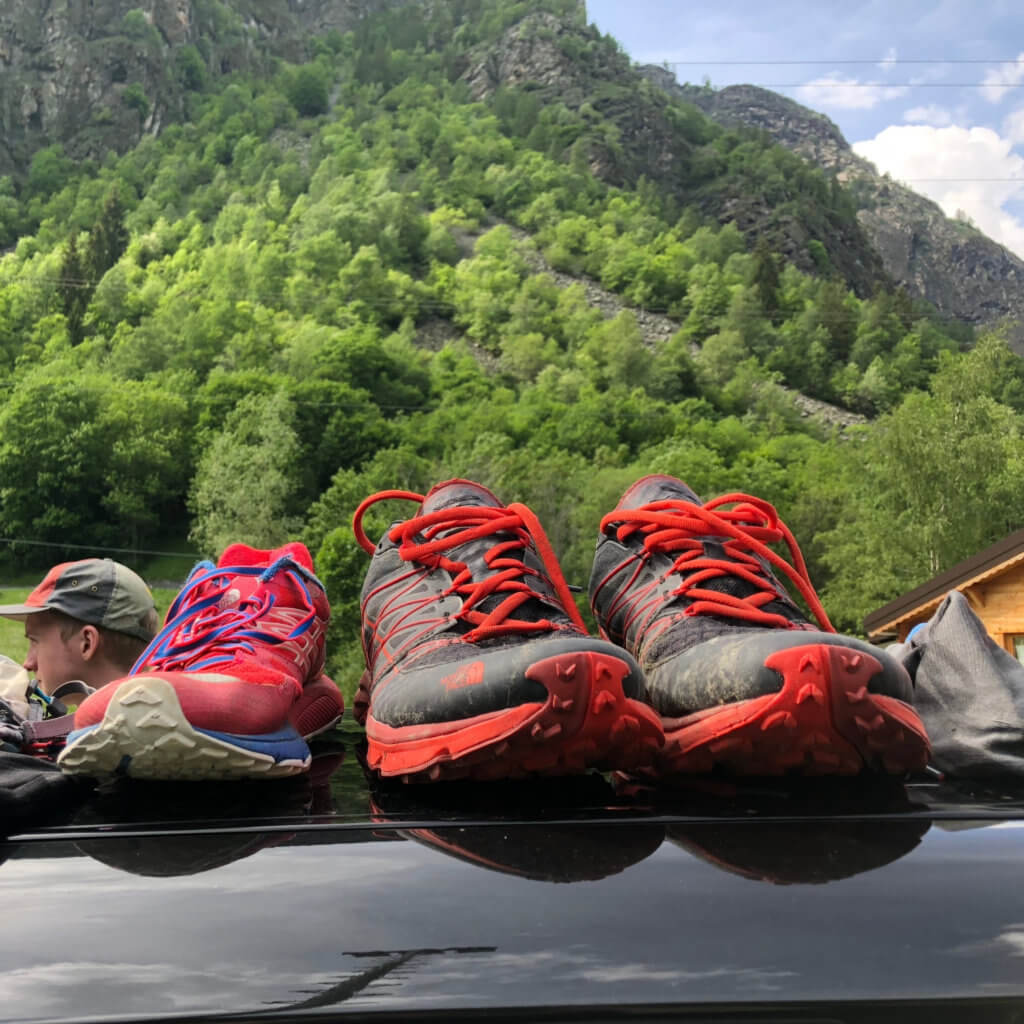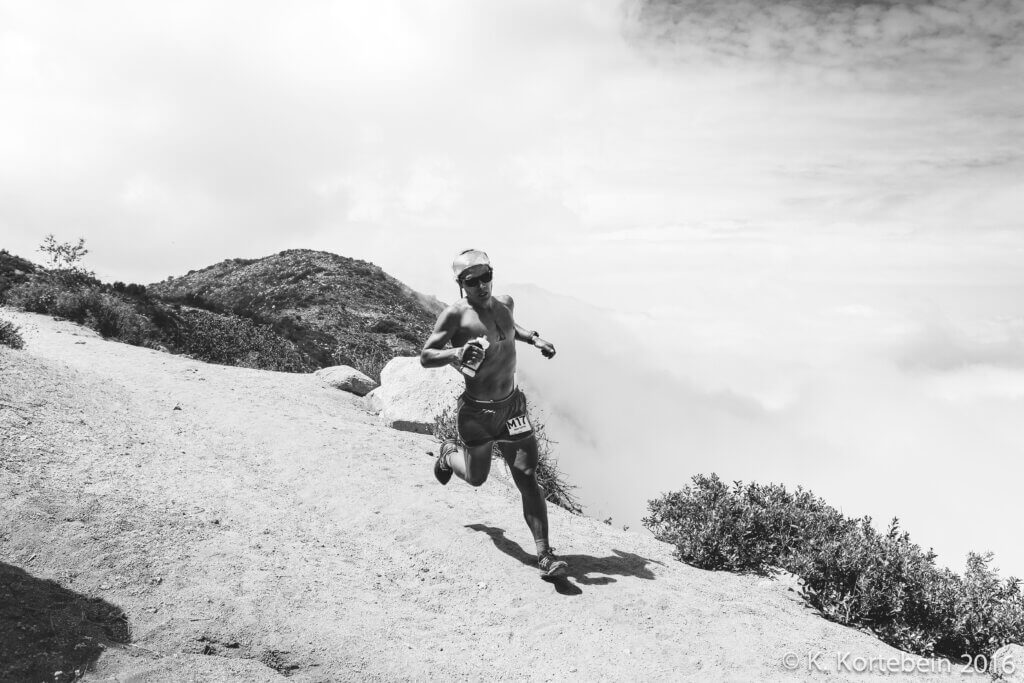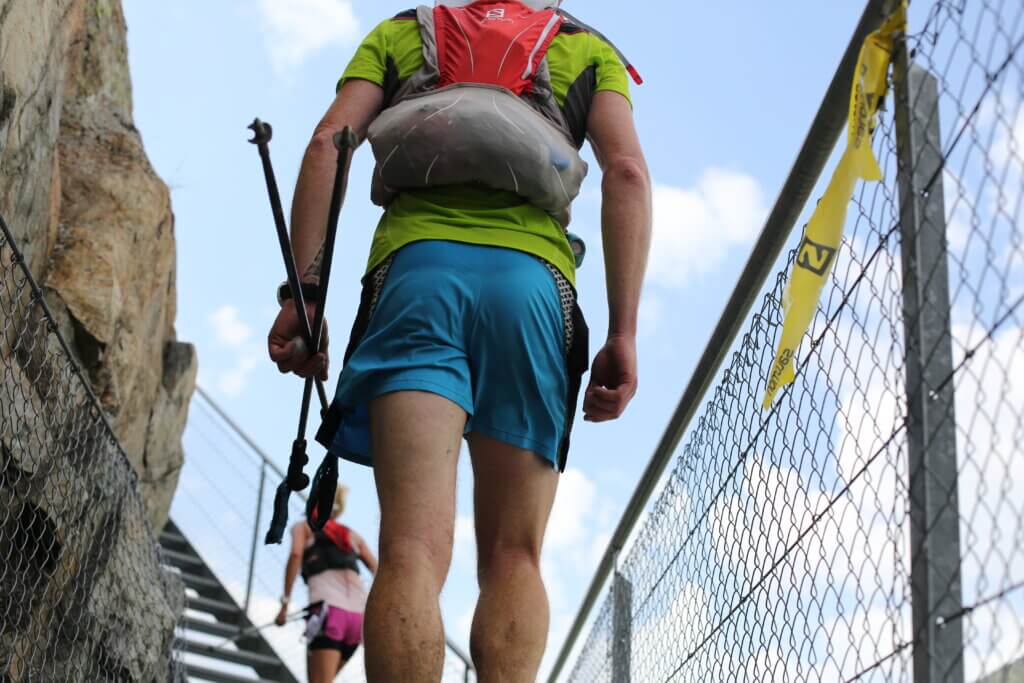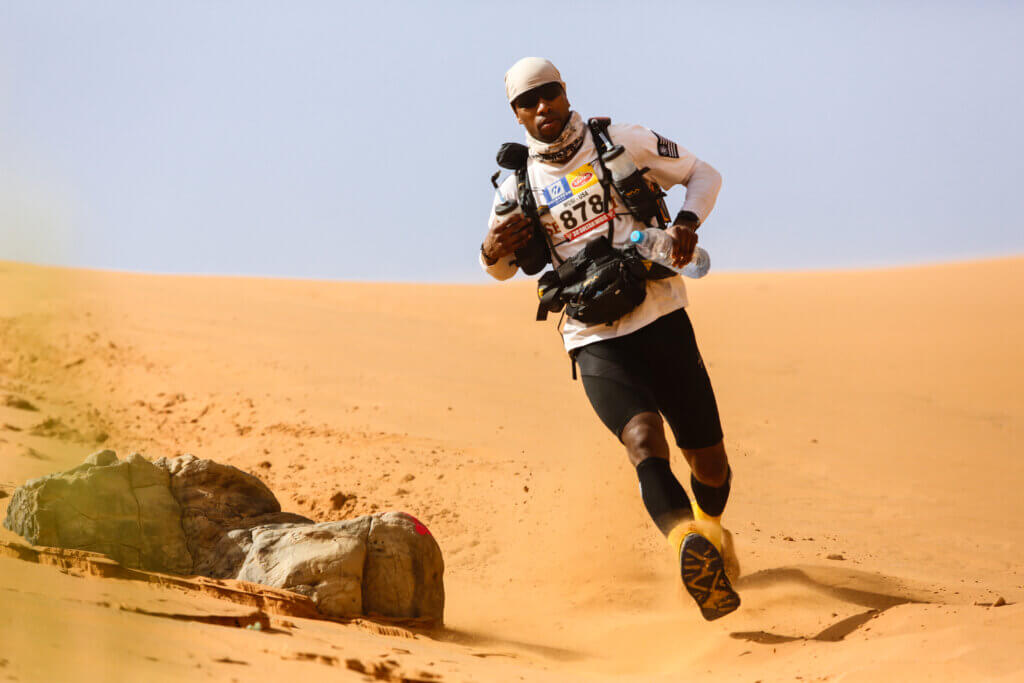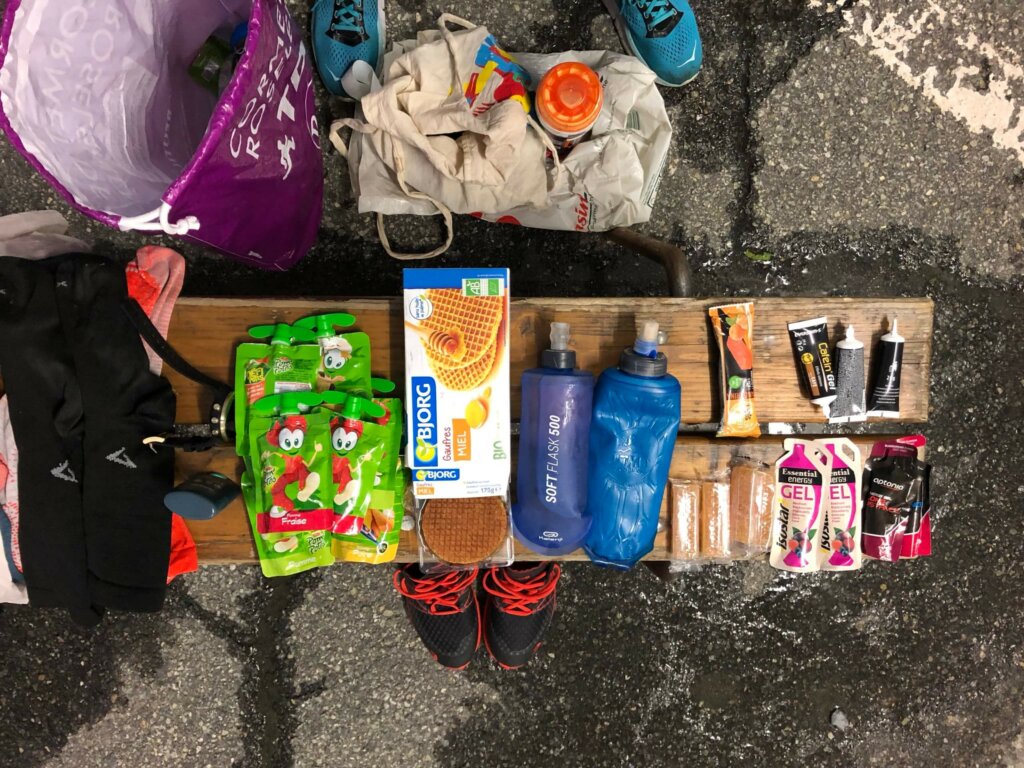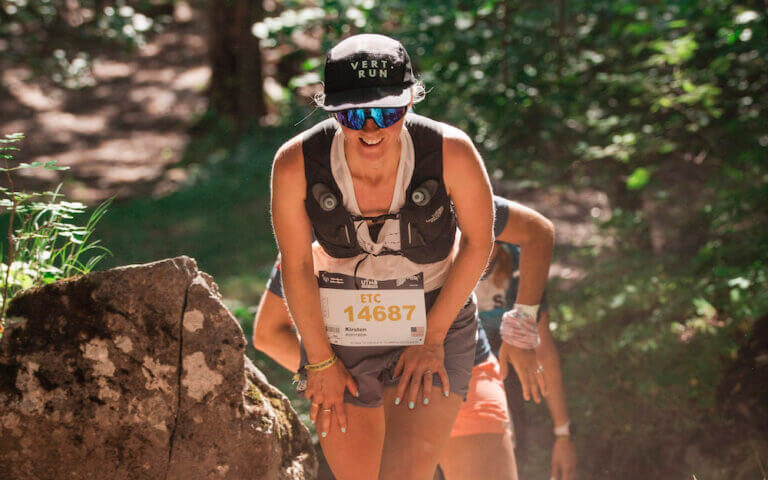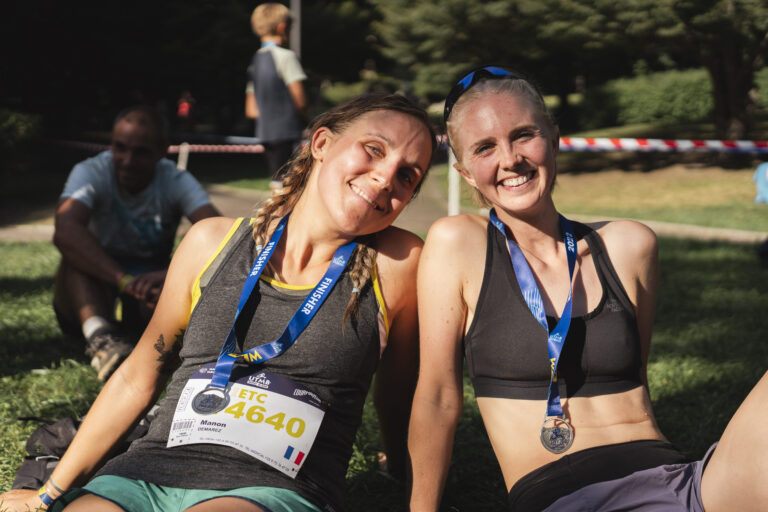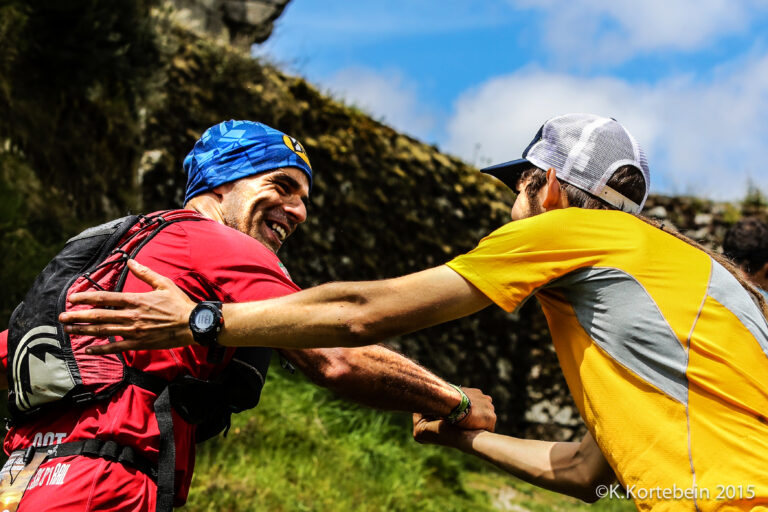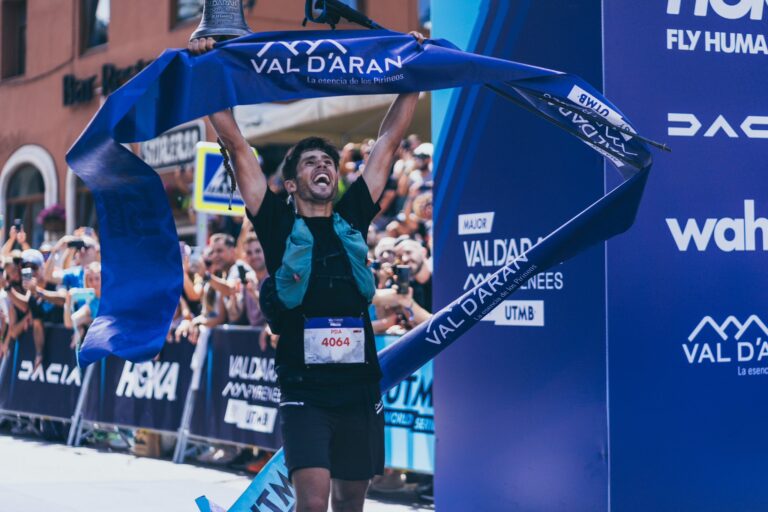Note: this article was originally a podcast episode on the Vert.run podcast. Click here to listen to the full episode!
We know that as trail runners, the questions never end. No matter how many years we’ve been trail running–and no matter if we’re prepping to run our first 5k trail race or our first 100 miler ultramarathon–there are always tons of things we ask ourselves about Trail Running Gear.
Common Questions About Trail Running Gear
- “Which trail shoes should I use?”
- “Should I rotate between different pairs of shoes, and if so, how many pairs should I have?”
- “Are those fancy new “carbon plate” trail running shoes actually worth it?”
- “Should I use poles for my race? (Or, why do people even use poles in the first place?)”.
- “How often should I eat during my race?”
Well, don’t worry–in this blog post, we’re going to answer all of those questions and more!
The format of this article is a transcript of a podcast episode from our popular trail running podcast “Running Long,” which is hosted by Vert.run coach Francesco Puppi.
In this blog post, Francesco (who lives in Italy) interviews two of our Vert.run coaches–Max Keith (lives in Chile) and Manu Ramirez (lives in Colombia)–and the three of them chat their way through all of the most common “Trail Running FAQs” that we get asked by our community of over 80,000 trail runners who train with Vert.run. Enjoy!
Listen to the Full Episode
Note: the transcribed version here in this article is a little shorter than the podcast itself. If you want the full conversation (and want to get to know Fran, Manu and Max!) give the full podcast episode a listen during your next long run or commute. It’s a great conversation and way to open your mind to new gear/nutrition ideas and tips…and honestly their convo is really cool, and you’ll feel like you’re hanging out with them!
Trail Running Gear Overview
Francesco: Welcome to our “Trail Running Q+A Session”! My name is Francesco and I’m here with two of our Vert.run coaches, Max and Manu, for an in-depth Q&A session on trail running gear and nutrition.
Let’s start off by talking about the most important trail running gear. Trail and ultrarunning gear is something that a lot of people get very passionate about.
Wide Variety of Options
I’m personally not too geeky or picky about my gear, and find that the current market for trail running gear offers a wide variety of options when it comes to shoes, specifically.
Recently, I’ve found that every pair of shoes I try is better than the last and companies are making great improvements to the technology and quality of the shoes that are out there.
Selecting Trail Running Shoes
My first question for you both is, if you had to pick a favorite trail shoe for any type of terrain or any distance, what would you choose?
Max: Personally, I guess I’m a little more picky about my running gear than you Fran…but I do agree that things have been improving a lot in the past 5-8 years.
Even though things are improving, I still feel that it is hard to find that “Holy Grail” of trail running shoes that works well for every distance and every type of terrain. I’m the kind of person that often runs from home to the trail, so I don’t usually wear an aggressive mountain-style shoe. I do run a fair amount of roads and dirt roads so I prefer a lighter, comfortable shoe. Typically, I don’t wear anything that weighs more than 280 grams.
Choosing Shoes Based on Terrain
Francesco: Right. I would say this: when choosing a pair of trail running shoes, the key is to think about where you will be running the most and what type of terrain these shoes will be used on. The shoes that are best for you will depend on a number of variables such as how long your training runs are, is the terrain rocky, root covered, flat, sandy, etc., and what kind of traction will you need.
For me, if I had to choose one shoe to train and race in, it would be the Nike Vomero.
I know it’s a pretty unpopular choice, but I find that the Vomero is a lightweight, versatile shoe that I can use on both roads and less technical trails.
Shoe for Technical Trails
When I am looking for a shoe that is better on technical trails, I look for something with good traction. For example, any shoes that have Vibram soles are typically very good. (Vibram is a company that specializes on the outsoles of shoes to provide high quality traction and grip.)
Some of my other favorite shoes for trail are the Nike Terra Kiger which is very light and a shoe I like for racing (the Terra Kiger is on their 8th version now) and the new ZoomX Zegama, which is the new shoe that Nike is launching this month.
Salomon Trail Shoes
Manu: My top pick for trail shoes is Salomon. I just love Salomon trail shoes!
One of my favorite models is the Salomon Speedcross. The Speedcross is great for mountain running, especially tropical mountain terrain like where I live in Colombia, where you need a lot of traction. So the stability of the Speedcross is definitely one of the staples of the Salomon brand.
Breathability Based on Climate
Another point I’ll mention is that it’s important to find shoes that are breathable depending on the climate where you are training. If you live in a hot, tropical place like I do, you have to remember that sometimes waterproof options are not always the best because they are not breathable for your feet.
Francesco: Yeah, that’s an important feature to consider. I see a lot of people that use Salomon tend to race in the Pulsar model, so that might be a good one to check out.
Favorite Trail Running Shoes by Max
Max: One of my all-time favorite shoes is the New Balance 1600. I have all six versions that they’ve come out with for this shoe, and I’ve run up to 80k in them and really loved the shoe. It’s a classic flat, road shoe, with not a lot of cushion, but it has worked well for me over the years.
Adidas Adios Line
Lately, I’ve been enjoying the Adios line from Adidas (like the Adizero), which is another pretty classic road shoe with mid-cushion, not a lot of cushion. It’s very lightweight, very breathable…which as Manu mentioned, like for him training in Colombia, it gets really hot here in Chile where I live and train (besides in the winter.) So, I really like to wear breathable shoes.
Mountain Running Shoes
As for proper mountain running shoes or which shoes to use for a Vertical Kilometer (VK), one of my top choices is the Dynafit Feline Vertical. I’ve found that they have good traction, are super lightweight, and feel secure. The only downside is that they fit a bit too narrow for me, so if you have a wide foot like I do, the Feline Vertical might not be the best choice for you (the only way to know is to try it on!) Other than that, they’re a great option for mountain running or shorter races.
Trail Running Gear : Importance of Purpose and Terrain in Shoe Selection
Francesco: In summary, it is important to think about the purpose your shoes need to fill, and the type of terrain where you are going to use your shoes the most. Usually, not one model alone is going to suit all of the varying types of terrain and distances you might run.
The shoe market is incredibly broad, so there are likely going to be many different shoes that fit your needs. One suggestion is to find a specialty running shop in your area that will let you test out different shoes or events and races that have demo shoes to test out.
Rotating Running Shoes
Max: Yeah, exactly.
And another recommendation would be to have about three different pairs of running shoes in your rotation to use depending on the terrain and how you will be running. Although it’s a bit of an investment, it helps to keep you from wearing through your shoes as quickly and gives you options depending on your training.
Looking for a Personal Coach? Get your Coach now at Vert.run
Trail Running Gear: Shoes with Carbon Plates
Francesco: Now we are going to discuss a little bit about carbon plates in trail running shoes. Do either of you have experience with running shoes with a carbon plate?
Max: The carbon plate has been all the hype the past 3-4 years and it’s no secret that the carbon plate technology is here to stay. I know trail running companies have now started to work on this technology – the ones that come to mind first are The North Face Fly Vectiv, Craft, and Speedland.
Differences from Road Shoes
Francesco: The idea of the carbon in a trail shoe is a little different from the carbon plates that are found in road shoes and usually used for the spring effect. Originally, in a trail shoe, the carbon was utilized only on the sides of the shoes to provide more stability without the extra weight.
Now, that seems to be changing a bit and you are seeing more and more trail shoes with the full carbon plate as well. For example, the Speedland shoes have a full carbon plate that is removable. Additionally, Nike is coming out with a trail model that has a full carbon plate, and will be best for non-technical trails, like the Western States 100, for example.
Benefits of Carbon Plate Shoes
For me, the main benefit that I’ve found in using carbon plated shoes like the Nike Vapor Fly is not only the spring and the momentum forward, but also the comfort and cushioning they provide. I have noticed that I recover more quickly after hard efforts or races in the carbon shoes.
Max: I agree. I’m a big fan of carbon plate shoes right now. I mainly have experience using them on the roads, but I was going to mention the same thing–
it’s incredible how you can bounce back and recover after a hard workout with carbon plate shoes.
I think that has been one of the most impressive things I have found with using carbon plate shoes. For example, I am able to go for a really long run, do specific speed work, and feel pretty decent afterwards. With a regular shoe, my legs will be trashed for a couple of days.
This new technology just feels different. If we can replicate that with trail shoes, I will be buying lots of carbon plate trail shoes, that’s for sure.
Role of Foam in Carbon Plate Shoes
Fran: I think it’s worth mentioning that some of that has to do with the foam and not the carbon plate alone.
Some models from Nike use the same material for the outsole but don’t have the carbon plate…and still offer great cushioning and are a nice training shoe that help you to recover faster than other shoe options.
Looking for a Personal Coach? Get your Coach now at Vert.run
Trail Running Gear : Poles
Fran: What is your experience with using poles in trail running races and training?
Manu: I have used poles in my 100+ mile races.
Using poles helps you a lot when you are doing long races with a lot of climbing, and where you are required to carry a lot of gear–like wearing a pack or vest of some sort.
Plus, a lot of the new trail running backpacks and waist belts have easy ways to store poles when you are not using them, so it makes the choice easier on whether or not to bring them for a run or race.
Advice for Beginners
Fran: Do you have any advice for people just getting started with using poles? How do you use them? For ultras and technical terrain, even for VK’s (vertical kilometer races), they can be very useful. What is your experience with and tips for using trail running poles?
Manu: The first piece of advice is to train with the poles as often as you can. The poles can be a big help in going uphill for the extra push and stability they provide especially if you have a pack on.
After you start training with trail running poles consistently, you will realize how much energy you can save in your legs because you’re using your upper body to propel yourself uphill.
This can be critical during long races where saving your legs is important, but you have to remember to practice with them…and you especially also have to learn how to fold them properly.
Choosing the Right Poles
It’s one of those pieces of gear that you have to do your research on, because there are many different options. For example, Leki has a model of poles that basically has a glove system where you can easily attach your hand/glove to your poles or disconnect from them quickly.
(Note: these Leki poles are the ones that our CEO and founder Moisés uses! This is the model he has.)
One of the good examples that I always give in terms of being very efficient with poles is Spanish ultrarunner Luis Alberto Hernandez. I feel like he is really amazing when it comes to using polls, and he has a good video on YouTube with specific tips that I use. I always send that to people when they are thinking about using polls for their races.
Trail Running Gear : Recommendations for trail running backpacks
Fran: What other pieces of trail running gear would you recommend? Do you use a trail vest, backpack, or waist belt?
I’m mostly comfortable with a belt because I don’t like to wear anything around my shoulders and prefer to move more freely.
I usually use a Salomon belt that is large enough to store two soft flasks (even though it’s not totally ideal, because with two soft flasks they start to bounce a little bit on the downhills) gels, a jacket, whistle and my cell phone if needed.
Vests or Belts?
For training, I tend to use a trail vest–Nike makes a good one, but when it is hot the vest is not always the best option because it makes you even warmer.
Max: I also tend to like using a waist belt. But nowadays, the list of mandatory gear that they’re requiring for races is getting longer and longer, so I may have to start using the vest more often. But for shorter races, I will always opt for the waist belt. I love the approach of running really lightweight.
Looking for a Personal Coach? Get your Coach now at Vert.run
Trail Running Gear : Backpacks with Camelback – how to refill it?
I Fran: One of our Vert.run athletes wrote to ask–does anyone have advice for refilling a Camelbak water bladder during a race? I always find it hard trying to deal with powders or tablets and water and everything. Do you have experience with that?
Manu: I used to run with a Camelbak quite often, but that was always an issue. You do have to take it off completely to refill it, unless you can get help from a volunteer at an aid station or something like that.
Unless you need to carry a large amount of water, I find it easier to use soft flasks and refill them more often. They are also more useful because you can easily tell how much water you’ve consumed and how much you have left versus the Camelbak in your backpack or trail vest that you cannot see.
Gels, Fueling, and More
Fran: We’ve been talking about hydration during a race–let’s talk a little bit about nutrition, specifically, gels.
At some point we’re gonna have to deal with nutrition during training and racing, and gels are probably the first choice that comes to everyone’s mind. The gel and nutrition products that are available on the market are just amazing, and there’s really a wide variety of flavors.
Favorite Gel Brands
My favorite gels are GU Energy gels–I find that their flavors are good, and they’re easy to digest. They have options with caffeine, without caffeine, and different water contents.
I will also mention Maurten gels as another one of my favorites. Although they are very expensive, they’re probably a top pick for many road runners and marathon runners.
The last brand I’ll mention is Science in Sport (SIS). Their flavor is less intense than other options I’ve tried, and that can be beneficial for longer races or if it’s hot and you are struggling to take in other nutrition.
Max: Francesco, What’s your favorite GU flavor?
Fran: Salted caramel–it’s pretty good.
Max: I like GU a lot as well, but I struggle a bit with their texture because they are so dense. If it is hot, I tend to go with a fruitier flavor that seems a bit lighter than the other options.
I have also been trying Maurten a bit, which are also a bit dense, but you feel the energy right away, which is something that I really liked.
It’s a high performance type of gel. And it’s probably one step above everything else. Maurten is totally focused on the performance side of nutrition, not on flavor.
Trying New Products
Manu: I’ve recently been trying some bars–called Altiva. The energy is just amazing. And it’s really easy to digest because it’s a vegan bar. Even the package is biodegradable.
Caffeine Considerations
Fran: A few other things to note are taking in gels with caffeine. Sometimes this is useful if you are running a long race or running through the night.
The thing that is a little tricky with caffeine is that you can easily get stomach issues. You want to try to practice, and be careful when it comes to caffeine. If you’re not very used to caffeine, when you take it, it has a much bigger impact and a much bigger effect on your body than if you are used to taking in caffeine every day.
Manu: One thing I always recommend to my athletes is to try out every single piece of gear and bit of nutrition that you plan to use on race day. Don’t try anything new the day of your race.
Looking for a Personal Coach? Get your Coach now at Vert.run
Nutrition During a Trail Running Race
How much should you eat during a trail running race?
Francesco: Usually, you want to try to eat or drink as much as possible because what you’re burning is always more than what you can get with your nutrition. There is a threshold of how much your body can process and digest while running.
Carbohydrate Consumption
Depending on the length and intensity of the race, you should aim to consume 60-120 grams of carbs per hour during a trail race–that is usually around two to four gels.
One gel is usually 20-40 grams, so you would need four per hour to meet the 120 grams. That might be a lot for some runners, so 2-3 gels may be better depending on how your stomach processes the gels.
You want to eat once every 20 to 30 minutes. You can even try to take two gels at a time, if that’s easier for you. Try to sip slowly, take your time, and drink as soon as you take the gel because that’s going to help you with digestion.
To digest foods and process the carbs, you need water–so it’s important to stay hydrated throughout the race. And remember: when it’s hot out, this becomes even more important.
Digesting Calories During a Race
Max: I’ve always struggled with being able to digest that amount of calories. For me, it’s very, very hard to achieve–I’m more in the range of like 80-90 grams. That usually means two gels an hour, but I will try to supplement with liquids that contain carbohydrates. For running longer races, it’s really important to be able to digest real food and that is something you can practice in training.
Importance of Training with Real Food
It’s very important to train those aspects, not just you being able to digest all those grams of carbs, but also being able to eat something else. I wish that trail running would be more similar to road cycling, sometimes, where they stop at a cafe, drink a coffee, eat a sandwich, etc.
Start Eating Early
Fran: One last thing–start eating early in the race, before you get hungry. Once you stop taking in food it’s hard to get things going and processing calories again.
You also want to make sure you include a wide variety of options in your training and nutrition strategy.
Conclusion:
We covered a lot today and we hope to have given you some useful tips or ideas to test in your next training sessions and long runs and races. It’s always useful to learn from other runners and other people. We hope you enjoyed this conversation and thank you again to Manu and Max for being here with me today.
Until next time, keep rocking the trails.
Want to take the guesswork out of how to train for your next trail race or ultramarathon? Check out our popular training programs her.

